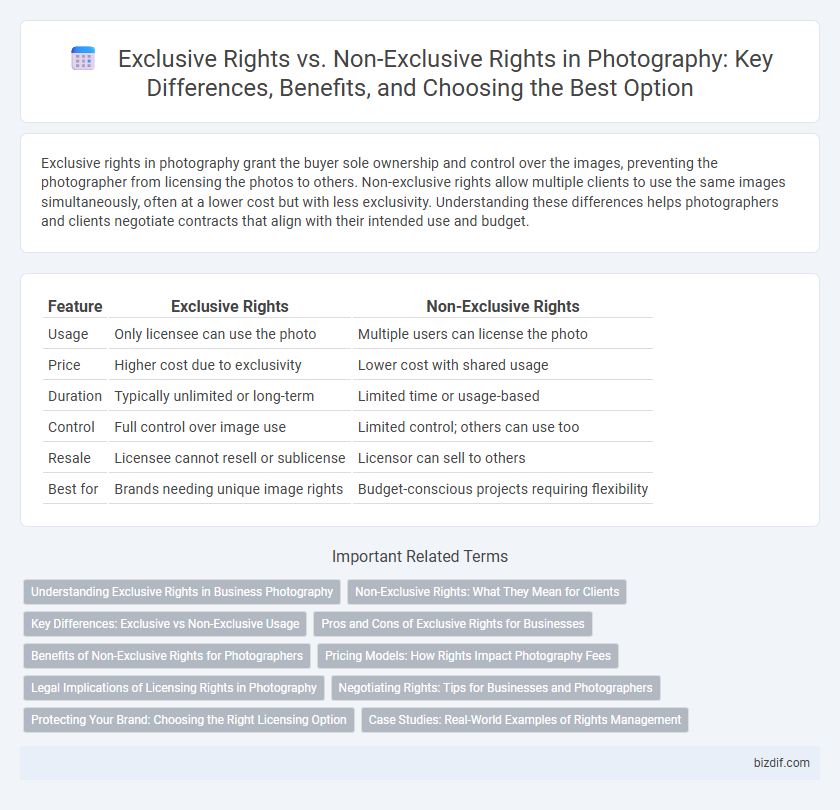Exclusive rights in photography grant the buyer sole ownership and control over the images, preventing the photographer from licensing the photos to others. Non-exclusive rights allow multiple clients to use the same images simultaneously, often at a lower cost but with less exclusivity. Understanding these differences helps photographers and clients negotiate contracts that align with their intended use and budget.
Table of Comparison
| Feature | Exclusive Rights | Non-Exclusive Rights |
|---|---|---|
| Usage | Only licensee can use the photo | Multiple users can license the photo |
| Price | Higher cost due to exclusivity | Lower cost with shared usage |
| Duration | Typically unlimited or long-term | Limited time or usage-based |
| Control | Full control over image use | Limited control; others can use too |
| Resale | Licensee cannot resell or sublicense | Licensor can sell to others |
| Best for | Brands needing unique image rights | Budget-conscious projects requiring flexibility |
Understanding Exclusive Rights in Business Photography
Exclusive rights in business photography grant the client sole ownership and control over the use of images, prohibiting the photographer from licensing or selling the photos to other parties. This exclusivity ensures a unique brand identity by preventing competitors from using similar visual content. Securing exclusive rights often involves higher fees but provides businesses with greater marketing flexibility and competitive advantage.
Non-Exclusive Rights: What They Mean for Clients
Non-exclusive rights allow clients to use a photograph while the photographer retains the ability to license the same image to others, providing more flexible and cost-effective options. Clients can utilize the photo for multiple purposes like marketing, websites, and social media without exclusive restrictions, but competitors may also access the image. This type of licensing suits businesses seeking broad usage rights without the higher fees associated with exclusive agreements.
Key Differences: Exclusive vs Non-Exclusive Usage
Exclusive rights grant the licensee sole permission to use a photograph, preventing the photographer or others from licensing the image to additional parties, which increases value and restricts competition. Non-exclusive rights allow multiple users to license and use the same photograph simultaneously, offering more affordable access but less control over image exclusivity. The choice between exclusive and non-exclusive usage significantly affects legal protection, pricing, and commercial potential in photography licensing agreements.
Pros and Cons of Exclusive Rights for Businesses
Exclusive rights grant businesses sole ownership of photographic content, ensuring full control over usage and preventing competitors from accessing the same images. This exclusivity enhances brand uniqueness and can increase market value but often comes with higher costs and limited flexibility for future collaborations. Companies must weigh the premium price and restricted adaptability against the advantage of having distinct, protected visual assets.
Benefits of Non-Exclusive Rights for Photographers
Non-exclusive rights allow photographers to license the same images to multiple clients, maximizing revenue potential without limiting their market reach. This flexibility encourages diverse usage opportunities, increasing exposure and portfolio growth while retaining ownership of the original work. Non-exclusive agreements also reduce legal complexities, enabling photographers to maintain creative control and negotiate terms with various licensors simultaneously.
Pricing Models: How Rights Impact Photography Fees
Exclusive rights in photography typically command higher fees due to the buyer obtaining sole usage privileges, which limits the photographer from licensing the images to others. Non-exclusive rights offer more flexible pricing models, allowing photographers to sell the same image multiple times at lower rates, maximizing revenue through volume sales. Pricing strategies must balance exclusivity premiums with market demand to optimize overall income from photography licensing.
Legal Implications of Licensing Rights in Photography
Exclusive rights in photography grant a single licensee full control over the use of an image, preventing others from legally reproducing or distributing the work, which significantly impacts potential revenue streams and legal enforcement. Non-exclusive rights allow multiple licensees to use the same image simultaneously, requiring clear contractual terms to avoid disputes over usage scope and geographic or temporal restrictions. Understanding and explicitly defining licensing rights in photography contracts is crucial for protecting intellectual property, managing infringement risks, and ensuring compliance with copyright laws.
Negotiating Rights: Tips for Businesses and Photographers
Businesses and photographers should clearly define the scope of Exclusive Rights versus Non-Exclusive Rights in their contracts to avoid misunderstandings. Negotiation should focus on usage limitations, duration, territorial scope, and financial terms to ensure both parties benefit fairly. Utilizing standardized licensing agreements or consulting legal experts can streamline the negotiation process and protect intellectual property effectively.
Protecting Your Brand: Choosing the Right Licensing Option
Selecting exclusive rights for your photography ensures complete control over how your images are used, safeguarding your brand's unique identity and reducing the risk of unauthorized exploitation. Non-exclusive rights allow multiple users to license the same images, offering broader exposure but less control, which could dilute your brand's distinctiveness. Understanding these licensing options helps photographers protect their intellectual property and maintain the integrity of their visual assets.
Case Studies: Real-World Examples of Rights Management
Case studies reveal that photographers granting exclusive rights to clients, such as editorial magazines, ensure unique control over image usage, preventing unauthorized reproduction and maximizing revenue through exclusivity agreements. In contrast, non-exclusive rights enable photographers to license the same images to multiple clients, as seen in stock photography platforms, increasing overall exposure but often resulting in lower per-license fees. These real-world examples highlight how rights management strategies directly impact revenue models and brand positioning in the photography industry.
Exclusive Rights vs Non-Exclusive Rights Infographic

 bizdif.com
bizdif.com